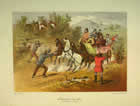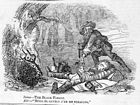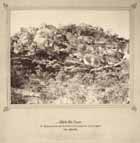Accounts of the gold rushes are peppered with the names of bushrangers like ‘Black Douglas’, ‘Velvet Ned’, ‘Long Bill’ and, most famously in Victoria, ‘Captain Melville’. The Black Forest – a densely timbered area that had to be traversed for nine miles on the way from Melbourne to the Mount Alexander and Bendigo goldfields – was considered prime bushranging territory and inspired fear in many a traveller: ‘I felt no apprehension ... ’til I entered the gloom of the Black Forest, when every doubtful person I met I dreaded might be a possible bushranger,’ recalled one squatter after a trip to Melbourne.
Many diggers told colourful stories of near escapes, and the Argus was not above providing fuel for the imagination with vague reports of well-armed men ‘skulking near the roadside’ on the way to the diggings. As historians and some contemporary observers have pointed out, such nebulous reports and tall tales exaggerate the extent of the problem, but the gold rushes provided obvious motivation for the first significant outbreaks of bushranging on the mainland. The earliest of these occurred in Victoria due, it’s speculated, to its proximity to the large penal settlements on Van Diemen’s Land.
Gold sscorts, transporting gold from the diggings to major towns, provided a logical target for bushrangers, but successful diggers with cash and/or horses (a valuable commodity for transport and working the mines) were also attacked. A number of bushrangers (including Black Douglas) were convicted of brutal murders, and there were some spectacular gold thefts, one of the most infamous being the robbing of the Nelson. The ship was about to sail with gold worth £30,000 when 22 armed men rowed out, seized the ship and got away with its booty. Only four of the men were ever captured. It’s not known who was behind this exploit, but legend favours the notorious Captain Melville - Frank McCallum.
McCallum, subject to violent, uncontrollable rages, was reputedly feared by friends and foes alike, but had an audacious, sometimes gallant, style that lent itself to legend. In December 1852, he carried out a series of robberies with William Roberts, including a well-publicised raid on a sheep station. In this exploit, the two bushrangers tied 17 male staff to a fence before ransacking the house – helping themselves to valuables as well as food and alcohol. As part of the same spree Captain Melville bailed-up two diggers on the Ballarat Road, robbed them of £33, and then returned £10 so they’d have some cash for Christmas.
Captain Melville certainly attained notoriety in his day, but neither he nor the other bushrangers who worked the roads to the Victorian diggings evoked the glamorous image of bushranging inspired by later ‘Wild Colonial Boys’ such as Ben Hall and Ned Kelly. Melville and his like were not folk-heroes; no elaborate shows of public sympathy accompanied the capture and demise of Frank McCallum, or any other bushranger, during the early years of the Victorian gold rushes.




